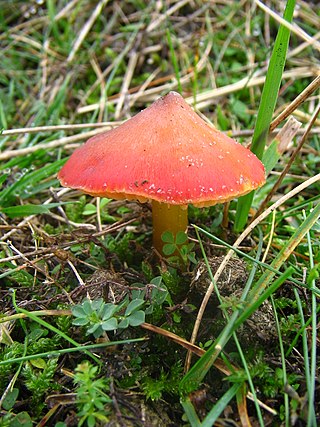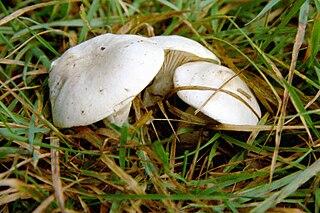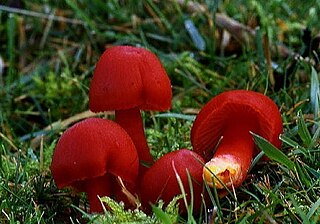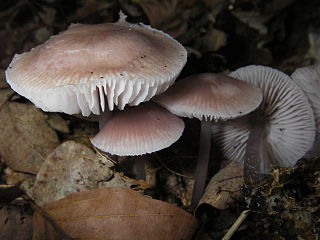
Collybia nuda, commonly known as the blewit or wood blewit and previously described as Lepista nuda and Clitocybe nuda, is an edible mushroom native to Europe and North America. Described by Pierre Bulliard in 1790, it was also known as Tricholoma nudum for many years. It is found in both coniferous and deciduous woodlands. It is a fairly distinctive mushroom that is widely eaten. It has been cultivated in Britain, the Netherlands and France. This species was reassigned to the genus Collybia in 2023.

Entoloma sinuatum is a poisonous mushroom found across Europe and North America. Some guidebooks refer to it by its older scientific names of Entoloma lividum or Rhodophyllus sinuatus. The largest mushroom of the genus of pink-spored fungi known as Entoloma, it is also the type species. Appearing in late summer and autumn, fruit bodies are found in deciduous woodlands on clay or chalky soils, or nearby parklands, sometimes in the form of fairy rings. Solid in shape, they resemble members of the genus Tricholoma. The ivory to light grey-brown cap is up to 20 cm (7.9 in) across with a margin that is rolled inward. The sinuate gills are pale and often yellowish, becoming pink as the spores develop. The thick whitish stem has no ring.

Tricholoma equestre or Tricholoma flavovirens, commonly known as the man on horseback or yellow knight is a widely eaten but arguably toxic fungus of the genus Tricholoma that forms ectomycorrhiza with pine trees.

Hygrocybe conica is a species of agaric in the family Hygrophoraceae. In the UK it has been given the recommended English name of blackening waxcap, since all parts of the basidiocarp blacken with age. In North America it is commonly known as the witch's hat, conical wax cap or conical slimy cap. Hygrocybe conica is known to be a complex of at least eleven closely related species and as such is widespread in Europe, North America, Asia, and elsewhere.

Pluteus salicinus is a European psychedelic mushroom that grows on wood. It is an edible mushroom after parboiling.

Clitocybe nebularis or Lepista nebularis, commonly known as the clouded agaric, cloudy clitocybe, or cloud funnel, is an abundant gilled fungus which appears both in conifer-dominated forests and broad-leaved woodland in Europe and North America. Appearing in Britain from mid to late autumn, it is edible, but may cause gastrointestinal issues.

Clitopilus prunulus, commonly known as the miller or the sweetbread mushroom, is an edible pink-spored basidiomycete mushroom found in grasslands in Europe and North America. Growing solitary to gregarious in open areas of conifer/hardwood forests; common under Bishop pine along the coast north of San Francisco; fruiting shortly after the fall rains. It has a grey to white cap and decurrent gills.

Hygrocybe coccinea, sometimes called the scarlet hood, scarlet waxcap or righteous red waxy cap, is a colourful member of the mushroom genusHygrocybe. These waxcaps are found across the Northern Hemisphere from China and Japan to Europe and North America. The small bright red mushroom is a familiar sight in unimproved grasslands in Europe in late summer and autumn, and woodlands in North America in winter.

Hygrocybe miniata, commonly known as the vermilion waxcap or miniature waxy cap, is a small, bright red or red-orange mushroom of the waxcap genus Hygrocybe. It is a cosmopolitan species, that is found worldwide. In Europe, it is found in fields, on sandy heaths, or grassy commons in the autumn. It is found in rainforest and eucalypt forest as well as heathland in Australia.

Ampulloclitocybe clavipes, commonly known as the club-foot or club-footed clitocybe, is a species of gilled mushroom from Europe and North America. The grey brown mushrooms have yellowish decurrent gills and a bulbous stalk, and are found in deciduous and conifer woodlands. Although considered edible, disulfiram-like reactions have been reported after consumption of alcohol after eating this mushroom.

Mycena pura, commonly known as the lilac mycena, lilac bonnet, is a species of mushroom in the family Mycenaceae. First called Agaricus prunus in 1794 by Christian Hendrik Persoon, it was assigned its current name in 1871 by German Paul Kummer. Mycena pura is known to bioaccumulate the element boron.

Pholiota flammans, commonly known as the yellow pholiota, the flaming Pholiota, or the flame scalecap, is a basidiomycete agaric mushroom of the genus Pholiota. Its fruit body is golden-yellow in color throughout, while its cap and stem are covered in sharp scales. As it is a saprobic fungus, the fruit bodies typically appear in clusters on the stumps of dead coniferous trees. P. flammans is distributed throughout Europe, North America, and Asia in boreal and temperate regions. Its edibility has not been clarified.

Tricholoma saponaceum, also known as the soap-scented toadstool, soapy tricholoma, soapy knight or soap tricholoma is an inedible mushroom found in woodlands in Europe and North America.

Lepiota clypeolaria, commonly known as the shield dapperling or the shaggy-stalked Lepiota, is a common mushroom in the genus Lepiota. It is widely distributed in northern temperate zones, where it grows in deciduous and coniferous forest. Fruit bodies have a brownish cap, a shaggy stipe with a collapsed, sheathing ring or ring zone, and spindle-shaped spores.

Pholiota squarrosa, commonly known as the shaggy scalycap, the shaggy Pholiota, or the scaly Pholiota, is a species of mushroom in the family Strophariaceae. Common in North America and Europe, it is a secondary parasite, in that it attacks trees that have already been weakened from prior injury or infection by bacteria or other fungi. It has a wide range of hosts among deciduous trees, although it can also infect conifers. It can also live as a saprobe, deriving nutrients from decomposing wood.

Deconica coprophila, commonly known as the dung-loving psilocybe, meadow muffin mushroom, or dung demon, is a species of mushroom in the family Strophariaceae. First described as Agaricus coprophilus by Jean Baptiste François Pierre Bulliard in 1793, it was transferred to the genus Psilocybe by Paul Kummer in 1871. In the first decade of the 2000s, several molecular studies showed that the Psilocybe was polyphyletic, and the non-bluing (non-hallucinogenic) species were transferred to Deconica.

Hygrophorus purpurascens, commonly known as the purple-red waxy cap, is a species of agaric fungus in the family Hygrophoraceae. Its cap has a pink background color with streaks of purplish red overlaid, and mature gills have red spots.

Hygrophorus olivaceoalbus, commonly known as the olive wax cap or sheathed waxy cap, is a species of fungus in the genus Hygrophorus. The fruit bodies (mushrooms) appear from midsummer to late autumn under conifers in North American and Eurasian mountain forests. The mushrooms have olive-brown, slimy caps with dark streaks and a dark umbo; the caps measure 3 to 12 cm in diameter. Other characteristic features include a slimy stem up to 12 cm long that is spotted with ragged scales up to a ring-like zone. As its name implies, the mushroom has a waxy cap and gills. It is native to North America and across the northern regions of Europe. According to a publication by the Council of Europe, the fungus is nearly extinct in France.

Tricholoma ustale, commonly known as the burnt knight, is a species of mushroom in the large genus Tricholoma. It is found in Asia, Europe, and North America, though those from North America may represent one or more different species.

Crepidotus applanatus is a species of fungus in the family Crepidotaceae. It was first described in 1796 by Christiaan Hendrik Persoon and renamed by Paul Kummer in 1871. It is inedible.




















